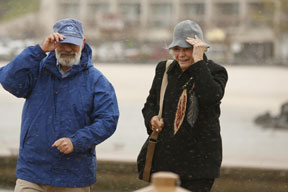Chancellor braves storm to tour VIMS
 Former Supreme Court Justice and current William
and Mary Chancellor Sandra Day O’Connor braved bone-chilling winds and
driving snow on April 7 to tour the College’s Virginia Institute of
Marine Science (VIMS) in Gloucester Point.
Former Supreme Court Justice and current William
and Mary Chancellor Sandra Day O’Connor braved bone-chilling winds and
driving snow on April 7 to tour the College’s Virginia Institute of
Marine Science (VIMS) in Gloucester Point.
O’Connor, who grew up on an Arizona ranch and who has been inducted into the Cowgirl Hall of Fame, showed her characteristic grit by stating that she wanted to go on a scheduled boat trip across the York River to VIMS “no matter what the weather, unless the captain says no.” Unfortunately, 30-mph wind gusts, 3-foot seas and heavy snow squalls forced the captain, Charles Machen, to keep the Pelican at the dock.
O’Connor’s visit to VIMS began across the river in Yorktown, where the Pelican, a former military landing craft that VIMS has converted into a research vessel, waited for her inspection. The vessel is particularly suited for studying the shallow, high-energy waters of coastal areas. Afterward, O’Connor was transported by van to Gloucester Point, where she toured the institute’s new seawater research laboratory, which will be one of the largest of its kind when completed later this spring. She also visited the laboratory of Steve Kaattari, professor of environmental and aquatic animal health, where she learned about his efforts to use the power of the immune system to develop biosensors capable of detecting waterborne pollutants. She then visited the laboratory of Deborah Steinberg, Class of 1964 Associate Professor of Marine Science, to learn about her studies of the tiny floating plankton that form the base of the food chain in Chesapeake Bay.
The visit to VIMS marked the first time O’Connor had toured the facility. Said John Wells, dean and director of the institute, “We were deeply honored by Justice O’Connor’s request to visit our campus and to learn about our role in marine research, education and advisory service. We only wish the weather would have been more cooperative.”
O’Connor had come to the Williamsburg area during the Easter weekend in order to introduce her granddaughter to William and Mary. On campus on April 9, she spoke to a meeting of the College’s Women’s Network and also engaged students in a conversation about “the rule of law” in an introduction to comparative politics class led by Rani Mullen, assistant professor of government.
O’Connor spoke to the women’s group about the reverberations of President Ronald Reagan’s decision to appoint her as the first female Associate Justice, about the reason she preferred being a judge to being a legislator—“As a legislator, people think they own you,” she said—and about the challenges women face in balancing their personal and professional lives. She also spoke about the value of work while responding to a question from one of the 100 members of the audience concerning equal work for equal pay. She noted that often a legal loophole preventing women from receiving equal compensation involves the fact that jobs are classified differently for men and women. She added, “I never worked for the money. Work worth doing, that’s what you want. It isn’t a question of money; it’s a question of personal satisfaction.”
In the government class, O’Connor engaged students in a discussion that centered on “judicial independence,” which, she explained, “is a facet of a broader concept called the rule of law.” She outlined the relationship between branches of government in the United States, and, alluding to Iraq, she suggested that, although “we talk about it easily here, it is hard to achieve.”
“The fact is, judges in a system have the power to make members of other branches angry,” she said. “That’s the risk.”
O’Connor steered the conversation toward the controversy that played out through 2005 surrounding the Terri Schiavo case. Legislators attempted to insert themselves in the judicial process by proposing legislation specific to a state court decision allowing removal of a feeding tube. O’Connor called the entire process “astonishing,” including the fact that “members of Congress [were] calling for mass impeachment of judiciary figures involved,” she said.
Responding to a question from a student, O’Connor said that the event did no long-term damage to the judicial system in the United States. “I hope that no precedent was set,” she said.
 Skip to main content
Skip to main content
